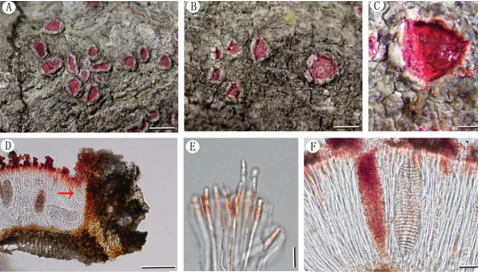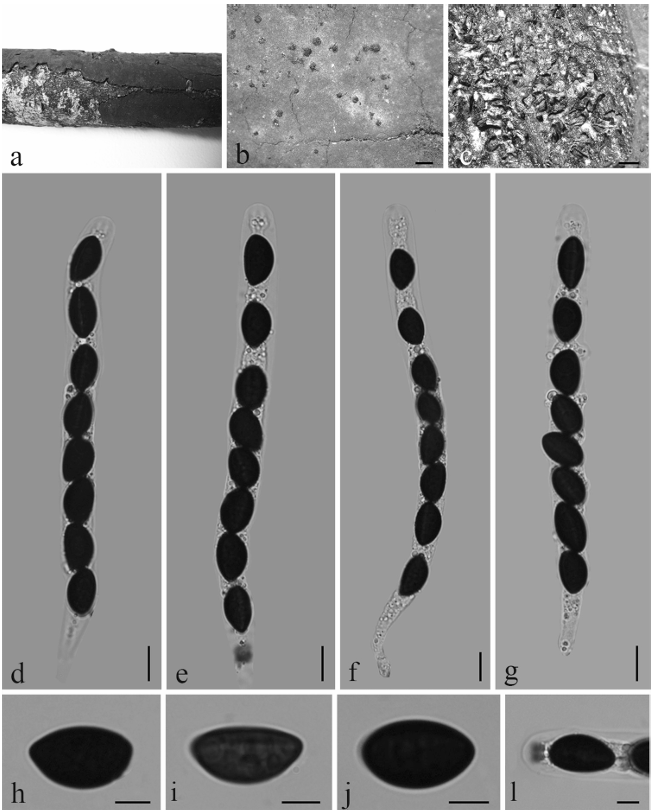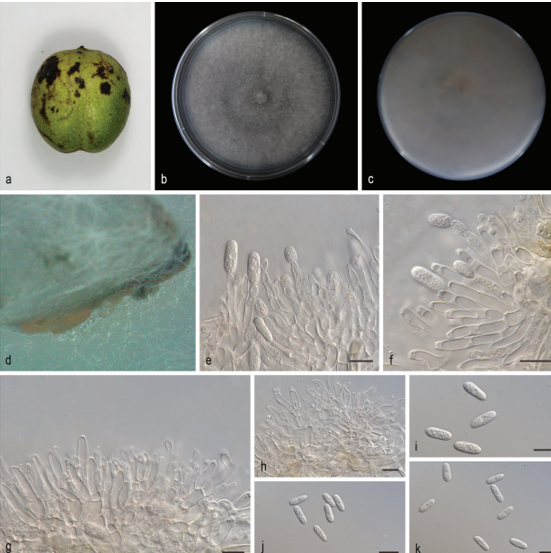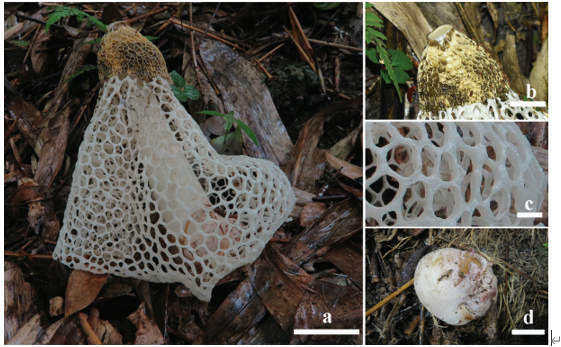Tomentella interrupta H.S. Yuan & Y.C. Dai 2020
Index Fungorum number: IF555624; Facesoffungi number: FoF 05631
Holotype: CHINA, Liaoning Province, Qingyuan County, Experimental Station of Forest Ecology, on rotten angiosperm wood debris, 23 October 2015, Yuan 10775 (IFP 019241, holotype); on rotten angiosperm branch, 3 August 2016, Yuan 11203 (IFP 019242), Yuan 11183, 11197 & 11243; Huanren County, Laotudingzi Nature Reserve, on rotten angiosperm branch, 20 October 2015, Yuan 10661.
Morphological description
Basidiocarps annual, resupinate, separable from the substrate, pelliculose, without odour or taste when fresh, 0.1–0.2 mm thick, discontinuous. Hymenophoral surface smooth, pale brown to brown (6D6–6D8) and concolorous with subiculum when dry. Sterile margin often indeterminate, byssoid, paler than hymenophore. Rhizomorphs present in subiculum, 10–20 μm diam; rhizomorphic surface more or less smooth; hyphae in rhizomorphs monomitic, undifferentiated, of type B, compactly arranged and of uniform; single hyphae clamped, slightly thick-walled, unbranched, 1–2 μm diam, pale yellow in KOH, cyanophilous, inamyloid. Subicular hyphae monomitic; generative hyphae mostly clamped and rarely simple septate, thick-walled, rarely branched, 3–4 μm diam, occasionally collapsed, not encrusted, greyish yellow in KOH, slightly cyanophilous, inamyloid. Subhymenial hyphae clamped, thin-walled, frequently branched, 4–6 μm diam; hyphal cells more or less uniform, greyish yellow in KOH, acyanophilous, inamyloid. Cystidia absent. Basidia 15–40 μm long and 5–9 μm diam at apex, 4–6 μm at base, with a clamp at base, clavate, stalked, sinuous, rarely with transverse septa, greyish yellow in KOH, greyish yellow in distilled water, 4-sterigmate; sterigmata 3–5 μm long and 1–2 μm diam at base. Basidiospores thick-walled, (7.5–)7 .9–9.2(–9.5) × (7–)7.4–8.7(–9) μm, L = 8.66 μm, W = 8.23 μm, Q = 1.03–1.08 (n = 60/2), irregularly globose or lobed in frontal view and ellipsoid in lateral view, echinulate to aculeate, reddish yellow in KOH, orange in distilled water, slightly cyanophilous, inamyloid; echinuli usually isolated, sometimes grouped in 2 or more, up to 2 μm long.
Habitat: On rotten angiosperm branch.
Distribution: In China.
GenBank Accession: ITS: KY686236, KY686237; LSU: MK446388, MK446389.
Notes: Tomentella galzinii Bourdot and T. viridula (Bourdot & Galzin) Svrček resemble T. interrupta in having discontinuous, very thin basidiocarps, thin-walled subhymenial hyphae, and the same size and triangular to irregularly globose basidiospores. However, the former species is differentiated by an olivaceous hymenophoral surface, acuminate, encrusted cystidia and the absence of rhizomorphs. T. viridula differs from T. interrupta by its capitate cystidia and the absence of rhizomorphs (Kõljalg 1996). Tomentella kentuckiensis is similar to T. interrupta by having a smooth hymenophore, the presence of rhizomorphs, thick-walled, clamped and simple septate subicular hyphae and irregular or lobed basidiospores of approximately the same size. However, it differs by having mucedinoid, continuous basidiocarps and slightly bigger basidiospores (8–11 μm diam, Larsen 1974).
Reference: Hai‑Sheng Yuan1,2· Xu Lu1,2 · Yu‑Cheng Dai3 ·

A basidiocarp of Tomentella interrupta (IFP 019241, holotype)









